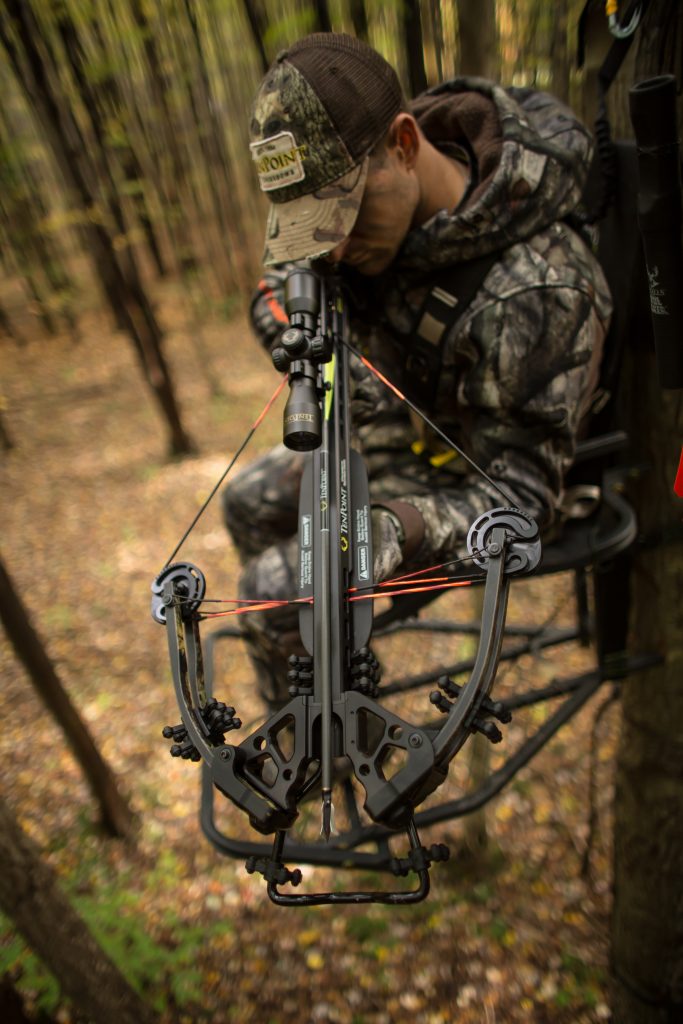
Think you don’t have to worry about the sound of your high-performance crossbow? Think again.
As part of the fifth-grade science curriculum in Virginia, 10- to 11-year-old students learn about sound. Other states are likely similar. Among the “essential understandings” is that sound is produced by vibration in matter, as well as that the speed of sound varies; atmospheric conditions and elevation, among other things, affect when supersonic velocities are attained. Students also learn that, although significantly slower than the speed of light, sound still travels fast; in fact, according to the NOAA National Weather Service Office, at sea level and 70° F. the speed of sound is 1,127.92 f.p.s. How do these fifth-grade lessons affect you, the crossbow hunter? Let’s see.
By Aaron Carter
Suppose that you’re using the TenPoint Turbo GT crossbow, which attains a respectable 360 feet per second with a 370 grain crossbow arrow. Let’s also assume that you’re taking a horizontal, 30-yard

(90-foot) shot at a deer. Not accounting for drag, it’ll take 0.25 second for the bolt to arrive on-target. Seems fast until you recall the above mentioned speed of sound. Why? The sound caused by the crossbow firing had traveled more than three times the actual shot distance in that same quarter-second period.
Another way to think of it, the sound arrives at the deer in 0.08 second (when rounded up). Calculating the difference, the animal has 0.17 second to react before the bolt reaches it. Although there is no consensus on a deer’s reaction time (or many animal’s, for that matter), the commonly expounded figures—expressed in milliseconds—are often faster than that 0.17 difference.
Suffice to say that your bolt won’t beat the crossbow’s sound to the animal, and at the deer will react to a degree (typically in an initial downward motion); hence the reason for the archer’s adage, “jumping the string.” As there’s no archery tackle that’ll outrun sound, it’s prudent to minimize the amount of sound produced by your crossbow. To do so requires a reduction in vibration; remember, vibration in matter causes sound.
One Simple Way
A simple way to reduce string oscillation (and thus vibration) is to add a string dampening setup to

your crossbow. To further reduce vibration (and reduce decibels), dampeners can be added to the limbs, bolt-retention spring, and barrel or your crossbow. TenPoint crossbows offers an easy-to-install, Bowjax-manufactured crossbow noise dampening package that included the three aforementioned types of energy–absorbing dampeners.
Noise-reduction dampeners can be mounted on the foot stirrup and accessories, such as the quiver, too. Silencers can be installed on the string; however, they must go in-between strands, otherwise they’ll be ejected in short order. The more you can reduce vibration the less sound your crossbow will produce.
A Second Possibility
Another way to quiet your crossbow is to use heavier bolts. Because more of the energy produced

during firing is imparted to the weightier bolt, there is less left reverberating through the crossbow. The tradeoff to doing so, though, is a more pronounced arc when shooting at longer distances. Keep in mind that there will always be a slight difference between the diagonal distance (from your tree stand) and the horizontal distance to your target, too—not too much to worry about, however.
Today’s high-performance crossbows, such as the TenPoint Carbon Nitro RDX, can still propel hefty bolts to considerable speeds. For example, when shooting a 420-gr. Pro V22 bolt it’ll reach 365 f.p.s.—only 20-f.p.s. slower than when shooting the much lighter 370-gr. Pro Lite bolt. Not only will the heavier bolt reduce vibration (and thus sound), but it also carries more kinetic energy.
One More Option
Lastly, just as sound of the crossbow firing and projectile flight alert targeted animals, so too can other non-firing noises. Perhaps the most audible sound from many crossbows, which is necessary at the moment of truth, comes from moving the safety switch from the “safe” setting to the “fire” mode. Flick the switch forward and you’re rewarded with a game-alerting click. To reduce the sound, once aimed simply pinch the safety button between the thumb and trigger finger of the firing hand and slowly ease it forward. Though not totally quiet, the reduction in noise is considerable.
Similarly, when using TenPoint’s Acudraw cocking system, while cranking the handle I use the thumb and trigger finger of my weak hand to cushion the lever’s back-and-forth movement, which prevents the continuous clicking. Doing so, I’ve been able to take two deer with two shots from the same group, and the rest were none the wiser.
There is much to alert big-game animals when hunting, including movement, scent, and sound. Concerning the latter, the figurative meaning of the idiom, “silence is golden,” is unobtainable. As you’ve learned in this article, though, you can still make your setup quieter, which you’ll benefit from when hunting with a crossbow or any other weapon.
— PAID PARTNER CONTENT. This content is brought to you by a D&DH advertising sponsor.

